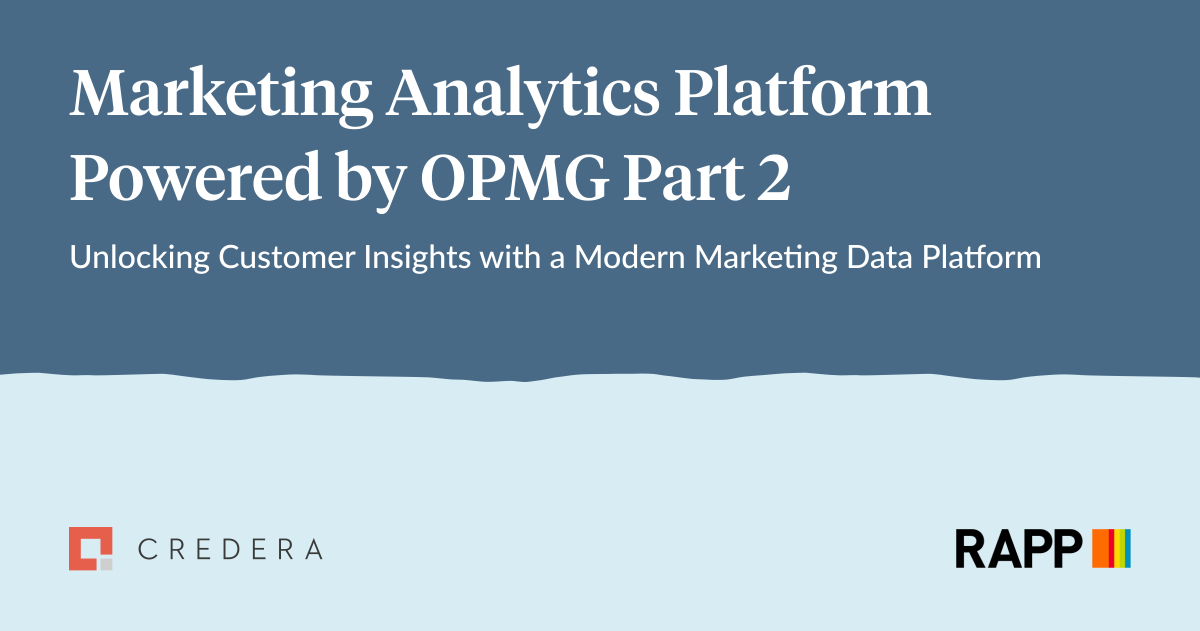Technology
Feb 16, 2022
Marketing Analytics Platform Powered by OPMG Part 2: Unlocking Customer Insights With a Modern Marketing Data Platform

In part 1 of this series, we introduced four steps to harness the value of customer data: unifying data, segmenting customers, orchestrating experiences, and measuring the journey.
Today, we continue the series by sharing how modern cloud data platforms, specifically marketing data platforms, enable marketers to accelerate these four steps and deliver differentiated precision marketing.
To better understand why a marketing data platform may be the key to accelerating your customer-data maturity and enabling precision marketing, we need to examine the evolving data landscape. Historically, organizations have relied on three types of customer data to drive insights: first-party data, second-party data, and third-party data.
First-party data is owned data collected directly through an organization’s website, email campaign interactions, customer service calls, product experiences, or other owned interactions.
Second-party data is another organization’s first-party data, collected and shared directly by a partner or supplier.
Third-party data is aggregated data such as web-browsing history, demographic information, and credit information often collected via third-party cookies or agencies.
The Value of First-Party Data is Exploding
In today’s advertising landscape, the ability to capture and leverage unique first-party data is essential for differentiating customer experiences with precision marketing. Unique first-party data offers organizations the opportunity to unlock unique insights. Organizations can leverage a rich and accessible collection of first-party data to segment customers and deliver experiences based on their brand story and an understanding of each customer’s lifelong journey.
While organizations have traditionally relied on second- and third-party data to build customer segments and marketing campaigns, its availability is rapidly declining. Recently, consumer digital privacy concerns have fueled restrictions on capturing and sharing third-party data: 96% of Apple iOS consumers opt out of ad tracking, Google replaced third-party cookies with Federated Learning of Cohorts (FLoC) technology, and General Data Protection Regulation (GDPR) and California Consumer Privacy Act (CCPA) regulations restricted the sharing of second-party customer data across organizations.
Access to external (i.e. second and third party) data is shrinking, so it is essential for organizations to collect first-party data about potential customers in order to deliver more meaningful customer experiences.
Unify First-Party Data in a Marketing Data Platform
Because first-party data is (by definition) unique, commercially-available customer data platforms (CDPs) are not designed to store and model all types of first-party data collected today. Instead, marketing organizations should extend CDPs with modern cloud engineering to create a marketing data platform and unlock differentiated customer insights.
Marketing data platforms allow organizations to unify and model all customer data. Customers can leverage so-called “Customer 360” models available in CDP offerings for standard customer information while extending and integrating these models with cloud data lakes and data warehouses for unique data types. CDPs like Tealium and data integration providers like Fivetran simplify this integration with tools and open-source building blocks.
Create Custom Algorithms for Segmentation and Next-Best-Action
In addition to storing and modeling customer data, cloud-powered marketing data platforms offer market-leading tools to train and apply custom algorithms. These algorithms can train on customer behavior over longer time periods to improve customer segmentation and next best action recommendations.
As one option, organizations can apply graphical tools like Alteryx or Dataiku to train algorithms with standard click-through or conversion metrics. Organizations with advanced data science teams (in house or through partners) can differentiate further by optimizing algorithms with customer-centric business metrics (e.g., lifetime value, likelihood to refer others, etc.).
Marketing data platforms also allow organizations to blend their own first-party data with second-party data available via a clean room in the second-party data provider’s environment.
In one example, a Credera pharmaceutical client leveraged Amazon Web Services to develop a marketing data platform that blended first-party data with Amazon Advertising data (second-party customer behavior data) without directly sharing data across organizational boundaries. This customer analytics workbench unified the client’s first-party data with second-party data from Amazon Advertising and allowed the client to train and apply customer segmentation algorithms in an Amazon Marketing Cloud (AMC) clean room. This solution allowed the client to learn from second-party data without sharing data directly across organizational boundaries. And, because the marketing data platform was developed with modern DevOps techniques, these algorithms were available to run both inside and outside of the AMC clean room.
Activate Customer Insights in Real Time
Marketing data platforms leverage the vast computing power of the cloud to unify customer data and tune custom algorithms for segmentation, targeting, and predicting next best action. However, these clever models are only valuable when they are applied to make real-time inferences and influence the customer journey at the right moments.
Therefore, marketing data platforms should be developed with modern cloud and data engineering patterns that are optimized for real-time data processing—streaming data architectures built with tools like Apache Kafka, Amazon Kinesis and Lambda, and/or Apache Flink. These predictions and recommendations from the marketing data platform must be activated via rapid dissemination to downstream channels. Reverse ETL features in CDPs like Tealium provide the capability to load data quickly into nearly a thousand downstream destinations.
Measure the Customer Journey
First-party data enables organizations to measure the customer journey beyond the initial purchase. Our colleagues at RAPP frequently advise clients that the most successful customer journeys can be represented as an infinity loop, which continues from purchase through to passion.
Including first-party experience data from product usage, customer support, and in-house community engagement alongside traditional outreach metrics helps organizations develop a deeper understanding of each customer’s unique journeys.

Figure 1 - RAPP Affinity Loop® shows how to continue the customer journey beyond purchase to create customer passion.
Bringing It All Together
As new data privacy restrictions increasingly limit the availability of second-party and third-party data, organizations must lean into the effective collection, unification, modeling, and activation of first-party data. While off-the-shelf CDPs provide functionality to use first-party data, a modern, cloud-based, marketing data platform enables organizations to fully utilize all their first-party data to effectively deliver relevant, timely marketing touchpoints throughout the customer journey.
Through effective implementations of custom, cloud-based marketing data platforms, and integrations with downstream channels, we have witnessed organizations increase customer lifetime value by 20% and decrease cost per action by 30%. For organizations looking to accelerate their customer data maturity—unlocking customer insights and enabling precision marketing—a modern, cloud-based, marketing data platform may be the key.
Up Next in Our Marketing Analytics Platform Series
This is part two of a multi-part series exploring how a single customer view powered by Tealium and AWS can help provide personalized customer experiences and increase the ROI of your marketing spend.
In part 3, we will discuss how marketers can leverage a unified MarTech Architecture to unlock precision marketing outcomes for their business.
Marketing Analytics Platform Powered by OPMG
OPMG’s Marketing Analytics Platform (MAP) is a technology toolkit for marketing teams to unlock value from their customer data. The toolkit blends enterprise patterns, cloud technology, and off-the-shelf software to unify customer data, segment customers, orchestrate real-time experiences, and measure the customer journey.
This content was created in partnership by RAPP and Credera, sister agencies and part of Omnicom Precision Marketing Group (OPMG). Omnicom Precision Marketing Group aligns Omnicom's global digital, data and CRM capabilities to deliver precisely targeted and meaningful customer experiences at scale.
Contact Us
Ready to achieve your vision? We're here to help.
We'd love to start a conversation. Fill out the form and we'll connect you with the right person.
Searching for a new career?
View job openings





